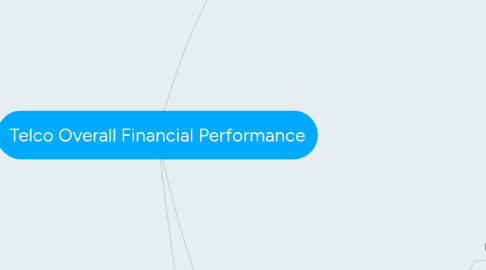
1. Revenue growth
1.1. Definition
1.1.1. Percentage change in revenue (sales) from period to period
1.2. Components
1.2.1. Churn
1.2.2. ARPU
1.3. Processes
1.3.1. Sales & Marketing
1.3.1.1. Activities
1.3.1.1.1. Market Investigation & Intelligence
1.3.1.1.2. Campaign and promotion mgt
1.3.1.1.3. Sales planning
1.3.1.1.4. Customer Approach
1.3.1.2. KPI
1.3.1.2.1. Churn rate
1.3.1.2.2. Average revenue per user (ARPU)
1.3.1.2.3. Minutes of use
1.3.1.2.4. Subscriber density
1.3.1.2.5. Cross-sell and up-sell effectiveness
1.3.2. Order Fulfillment & Service Activation
1.3.3. Product Development
1.3.4. Network Development & Mgt
1.3.5. Dealer Support & Customer Care
1.4. Influencers
1.4.1. ARPU and Churn
1.4.2. Service and Product Mix
1.4.3. Fixed Line
1.4.4. Pricing Strategy
1.4.5. Acquisitions
1.4.6. Foreign Exchange
1.4.7. Prices Changes
2. Profitability
2.1. Definition
2.1.1. Profits as a percentage of revenue
2.2. Components
2.2.1. Profit Margins
2.2.1.1. EBITDA
2.2.1.1.1. Calculation
2.2.1.1.2. Drivers
2.2.1.1.3. Use
2.2.1.1.4. Typical value
2.2.1.2. Operating Income Margin (OIM)
2.2.1.2.1. Calculation
2.2.1.2.2. Why?
2.2.1.2.3. Use
2.2.1.3. Net Income Margin (NIM)
2.2.1.3.1. Calculation
2.2.1.3.2. Use
2.2.2. Cost of Services Sold
2.2.2.1. Drivers
2.2.2.1.1. Customer acquisition costs
2.2.2.1.2. Customer care costs
2.2.2.2. Processes
2.2.2.2.1. Network Development & Mgt
2.2.2.2.2. Product Development
2.2.2.2.3. Procurement & Logistics
2.2.2.2.4. Supplier & Partner Mgt
2.2.2.3. Influencers
2.2.2.3.1. Pricing strategy
2.2.2.3.2. Price Changes
2.2.2.3.3. Customer Acquisition and Churn
2.2.2.3.4. Outsourcing
2.2.2.3.5. Access
2.2.2.3.6. Accounting Practices
2.2.2.3.7. Foreign Exchange
2.2.2.3.8. Service and Product Mix
2.2.2.4. Typical value
2.2.2.4.1. 30 - 50 % revenue
2.2.3. Cost of SG&A
2.2.3.1. Drivers
2.2.3.1.1. Salaries
2.2.3.1.2. Marketing, Advertising, Promotion,...
2.2.3.1.3. Sales comissions expenses
2.2.3.1.4. IT costs
2.2.3.1.5. Call centers
2.2.3.1.6. Professional Services fees
2.2.3.1.7. HR
2.2.3.1.8. Finances & Accounting
2.2.3.1.9. Sales channels
2.2.3.2. Processes
2.2.3.2.1. IT
2.2.3.2.2. Financial & Assets Mgt
2.2.3.2.3. Sales & Marketing
2.2.3.2.4. Dealer Support & Customer Care
2.2.3.2.5. Legal & Public Relations
2.2.3.2.6. HR
2.2.3.3. Typical value
2.2.3.3.1. 20 - 30 % revenues
3. Capital Utilization
3.1. Definition
3.1.1. Money of revenue generated per unit invested in capital
3.2. Components
3.2.1. Fixed Asset Utilization
3.2.1.1. Definition
3.2.1.1.1. Amount of revenue that is generated per unit of currency that is invested in net Property Plant and Equipment (PP&E).
3.2.1.1.2. Net PP&E is the book value of the gross PP&E less any accumulated depreciation.
3.2.1.2. Goal
3.2.1.2.1. Maximize
3.2.1.3. Influencers
3.2.1.3.1. Age of Assets
3.2.1.3.2. Operating Leases
3.2.1.3.3. Outsourcing
3.2.1.3.4. Access
3.2.1.3.5. Capacity Pressure
3.2.1.4. Processes
3.2.1.4.1. IT
3.2.1.4.2. Network Development & Mgt
3.2.1.4.3. Financial & Asset Accounting
3.2.1.5. Typical value
3.2.1.5.1. 0 - 5 %
3.2.2. Cash Operating Cycle (cash-to-cash cycle)
3.2.2.1. Drivers
3.2.2.1.1. + Days in inventory
3.2.2.1.2. + Days Sales Outstanding (DSO)
3.2.2.1.3. - Days Purchases Outstanding (DPO)
